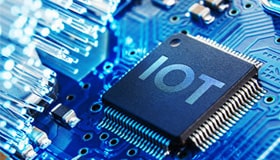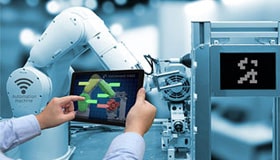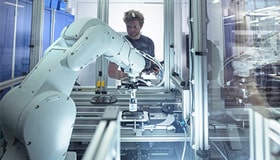Personalized Internet of Things for enhanced customer experience
As with the demand for a seamless experience, customer expectations are constantly changing and evolving. The Internet of Things helps meet these requirements by collecting personal information and experiences. Second, the demand for the Internet of Things is increasing with COVID-19 as airports, retail stores, schools, public transport, and entertainment industries need to develop smart spaces.
Digital retailers are the fastest growing segment of the Internet of Things, with other devices such as kiosks thriving. Other types of IoT solutions for smart spaces include keyless access, thermal screening, face mask recognition, remote social monitoring, interactive displays, and disinfector robots.
Bringing IoT devices online at incredible speeds gives marketers an unprecedented opportunity to personalize the customer experience and deliver the right content their audiences want, at the right time. As Target Marketing explains, the Internet of Things allows people to access branded content anytime, anywhere. Viewers can now test the contents of the drive whilst cleaning the kitchen or taking a walk in the park, instead of plugging in their smartphone and desktop computer. As a result, IoT will soon be usable in a variety of personal and private environments.
Preconditions for personalization
IoT devices enable enterprises to understand the needs of their customers and offer products that meet their specific needs. From offering related products to increasing customer loyalty, the Internet of Things has a huge impact on personalization. When building the foundations for your personalization strategy, the below points must be considered:
- Knowledge about the target audience
- What are the different ways to reach the audiences
- What are the messages which are going to deliver
- What time is suitable to reach the audiences
By defining how to get the right content to the right people at the right time through the right channels, you can always deliver personalization to your customers. To achieve this, high-quality data on customer behavior and needs must be readily available. It can be customised based on route data, location data, transaction data, and third-party data. Data solution and backup integration is required for optimisation alerts. Combine this customer insight and experience to form the basis of your personalization strategy through the unique value of the products that you deliver. The figure below shows the customer expectation.

Fig 1: customer expectation
In every industry, increasingly fierce competition between companies requires the use of different tactics to gain an advantage. One such tactic is service personalization. All companies strive to better serve their customers. This ultimately drives consumer demand for more personalized services. The Internet of Things can help businesses meet customer needs for personalized services.
The Internet of Things and Big Data are helping to improve customer service, and storing large amounts of data along with data collection is also a challenge, but Big Data can solve it. Without the Internet of Things, customer data can also be a headache. For example, when a customer purchases a product from your online store, and receives an email containing other products that the customer may not find useful. But now, with the help of the Internet of Things, companies can market their product listings to customers based on real-life situations. For example, when a customer purchases a product, the same related product or accessory may be offered on behalf of that product.
Interactions between the company and its customers were limited to point of sale. Businesses needed to gather information from customer reviews, surveys and complaints to understand customer needs and behavior. But now businesses with IoT devices can collect real-time data from customers and actively engage with them. By analysing the collected data, companies can anticipate and respond to the demands of their customers. For example, sales teams can use data to understand and meet customer needs when conducting sales.
Improving customer experience through IoT
The rapid development of the Internet of Things is changing the perspective of marketing. For this reason, many brands and marketers are rethinking their strategies. Integrating the Internet of Things can not only increase sales, but also improve the customer experience. Below are few considerations which improve customer experiences.
Real-Time data
The Internet of Things enables businesses to collect critical data in real time and define strategic actions. From device performance management to product monitoring, IoT gives potential customers instant access to better service. Sensors can also be installed on transport vehicles to inform customers of the transport experience. Wearable health devices such as wrist band, pulse oximeters and smart sensor devices improve the quality of life and revolutionize customer experiences.

Fig 1: customer expectation
Personalized communication
The Internet of Things is also used to improve communication. From operations management to insight into customer behavior, IoT can generate data that is critical to your business. Insights help you to personalize your relationship with your customers and increase their satisfaction. Product sensors can send information about usage patterns. We can use this data to reach customers through personal communications.
Digital Security
Digital security is very important to users. In a world where personal information theft and hacking are rampant, it is important for users to know that their personal information is safe in your hands and on your website. Despite some risks, IoT ultimately provides a more secure environment for hosting information.
Optimising product
You can use the Internet of Things to collect a lot of data. This data set helps us improve our products. You can increase the overall value of your product based on the data you get from using it. IoT data can be used to determine product performance. Based on this, we can discover potential problems and create better products. You can also use it to inform customers about their product’s performance and decide when to perform maintenance. This benefits customers and strengthens your relationship with them.
Inventory Management
In today’s competitive environment, customers want products to be delivered quickly. To meet these needs, you need to manage your inventory effectively. The Internet of Things enables inventory management to ensure that products do not run out. Radio Frequency Identification (RFID) tags are one of the most popular trends in IoT technology. Each of these tags has a unique fingerprint containing encrypted data that shows the team information for a specific item, such as colour, weight, model, type, and batch number. This will make it easier for your team to track inventory, as well as improve the customer experience with up-to-date product availability information.
Personalization is an ongoing process that must evolve and update as customer expectations change from a modern digital perspective. When implementing privatisation, decision makers should keep in mind that privatisation itself is not a successful digital transformation strategy. It is always important to adopt a balanced approach that ensures relevance and effectiveness and reflects the company’s values, perspectives and audience. To successfully improve the customer experience, you need to add value to your customers.






